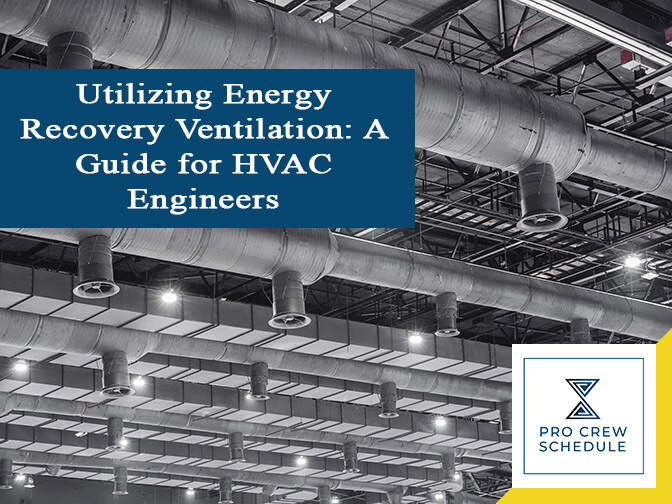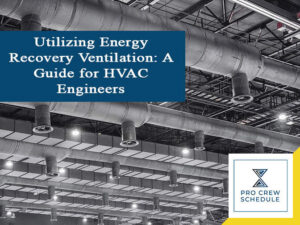In HVAC Engineering, one of the practical energy efficiency measures is ERV or Energy Recovery Ventilation. The HVAC professionals who are an expert in heating, ventilation and air conditioning know that one of their primary responsibilities is to coax an optimal performance out from the equipment to produce an increasing indoor air quality without unnecessary energy costs. Indeed, it is the primary reason why many of the HVAC experts are paying so much attention to ERV today and emerging software technologies like the construction scheduling software.
Since ERV systems lessened the utilization of external energy inputs, it plays now a critical role in passive house design. This type of system not just improves humidity control but also reduces the workload on cooling and heating systems that are both beneficial in many ways. It also allows the use of small tools and equipment, resulting in too much capital expenses reduction. In addition to that, the use of crew schedule software has also proven to offer many benefits in project management and other construction aspects.
For this blog, ERV will be explained in detail, including how it works. A comprehensive guide for using ERV will be outlined below.
How Does ERV Exactly Work?
An ERV typically operates on the fundamental basis of the air-to-air exchange theory. A stationary core device or spinning wheel utilizes the air’s counter-flow to remove the stale air from a building’s insides while retaining the air temperature. ERVs usually use HVAC exhaust air to efficiently precondition the air supply to enter the outdoor humidity and weather facilities. This particular process recovers most of the cooling and heating outputs that would probably be lost. The HVAC engineer uses builder trends software to effectively and meticulously manage the entire flow and the overall project’s development.
- Amidst the winter season, the ERV system is capable of preheating the air supply, extracting heat right from the warm exhaust air
- Amidst the summer season, the ERV system is capable of pre-cooling and dehumidifying the outdoor air supply through exchanging energy with the drier and cooler exhaust air
- ERV can reduce the electricity consumption of any HVAC systems while enhancing the indoor air quality
While thermodynamics laws currently limit each device, an ERV system couldn’t achieve 100% energy recovery. AHRU will officially certify the effectiveness of ERV units. It will change based on the environmental conditions – the performance is typically defined separately during winter and summer conditions. To follow-up on the changing understanding of ERV units, it is advantageous to use a task scheduler software. HVAC contractors can further track everything that is going on along the way while a project or a service is currently executed.
Sensible Heat vs. Latent Heat in ERV Systems
HVAC professionals must have a deeper understanding of the significant differences between latent and sensible heat to get a clearer picture of how a particular ERV system operates. Furthermore, what also is considered as a critical thing is the implementation of construction crew management. This time around, it is solely for the involved crew participating in the installation, for they need uniformity and well-planned team supervision. The sensible heat is typically involved in temperature changes while the latent heat has involvement in phase changes like water evaporation and the like. ERV systems are designed to interchange or exchange both types of heat or sensible heat only. Take note of the following conditions.
- ERV systems that will exchange both sensible and latent heat can use the exhaust air to dehumidify or humidify the supply of air.
- ERV systems that will only exchange moderate heat will either pre-cool or preheat the air intake relying upon the current season yet without humidity exchange.
- Humidity coming from the air supply will be transferred to the exhaust airstream
- If ERV is not present, the air conditioning system should be handling the dehumidification load and full cooling load
- ERV system is capable of reducing both loads instantaneously
One of the incredible benefits an ERV system has offered is the reduction or total removal of humidity. ERV Unit ratings are typically based upon the CFM, and it provides 2 types of Energy recovery – sensible and latent once again.
For new constructions, utilizing ERV from the very beginning might allow HVAC Engineers to downsize air conditioning systems’ heaviness. The application also of a builder trends software will also make the process and work much more manageable. Scheduling of tasks and supervising all involved crew is much more comfortable using this advanced tool. It will now lessen energy consumption and upfront expenses, which is very beneficial and practical. ERV operations are usually reversed during the winter season, but the benefits gained are most likely similar – the unit lessens the overall heating output required from boilers or furnaces.
For Indoor Air Quality, ERV is the best choice!
Most HVAC professionals often agree that ERV is incredibly the best choice for indoor spaces in terms of air quality. These experts have also both agreed that the application of a task scheduler software for better and more efficient scheduling and task-managing purposes. For starters, systems with positive pressure commonly rely on the HVAC system’s blower, yet it doesn’t need to for ERV. ERV contains a fan that is usually less powerful than the HVAC fan, yet ERV is still powerful enough to ventilate the entire spaces fully.
This difference might seem to be minor, but realistically, it is huge. Here are the reasons why:
- Consistency – HVAC professionals, know that HVAC blower fans will be more than powerful in performing a sort of air exchange for over 24 hrs. Hence, it is obvious to say that it will cycle on and off to provide the same amount of ventilation in terms of intervals. If that is the case, then it wasn’t ideal at all. That is why HVAC engineers have to ventilate it all the time if necessary. ERV fans should be running all the time to provide more consistent ventilation.
- Efficiency – Compared with HVAC blower fans, the fans of ERV systems are less expensive to operate. It has been known as less powerful as well and will cycle less frequently. Thus, it can ventilate the entire indoor spaces without having the utility bill increase rapidly. The best way to manage and track every move while the process is still going on is through a crew schedule software. Projects, installations, or any services provided can all be easily monitored using this advanced tool.
- Control – The ERV independently operates, and it will be easy for HVAC experts to verify the amount of air efficiently. It’s all being tied to the HVAC system with different power levels and there’s only one right inside the dehumidifier.
Overall, ERV offers better consistency when it comes to ventilation and more control over the amount of fresh air. Furthermore, the installation of ERV in any indoor spaces provide tremendous benefits. Below are some of the fantastic services it provides:
- Filtering and Elimination of allergens and other toxins existing in indoor spaces
- Prevent odor and biological growth
- Energy savings are increased consistently
- Improving overall situation due to a much fresher cycled air
- Extending the lifespan of HVAC system
- Keeping the temperature consistent from one room to the others
- Mitigating mildew risks and mold
- Dependency on air conditioning is reduced
The most significant ERV advantage is ventilation. A much smaller yet still very essential and substantial benefit is humidity control. As previously stated, ERVs are capable of transferring humidity from incoming air towards the outgoing air. That has been truly great during summer. However, during the winter season, ERV can transfer moisture right from the outside air towards the incoming air.
Code Compliance for ERV System
When it comes to HVAC installations, there are many other additions and one of which is ERV. What others didn’t know about is that ERV is a significant subject to building code requirements. However, it is essential to be reminded of or take note of the building and weather conditions. In fact, not all weather and building conditions are perfectly suitable for ERV. Thus, the investment might not be justified under several circumstances.
Finally, ERV systems must virtually meet the ASHRAE 62.1 and 62.2 requirements for indoor air quality and ventilation.
Key Takeaways
Energy Recovery is usually complicated. Many factors are necessarily considered and should come in to play. HVAC Engineers should be able to specify the best ERV system according to the weather conditions and building needs. The need to familiarize the code requirements is ultimately necessary because it is an effective way to acquire project approvals quickly.







